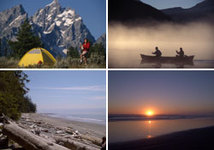The unofficial BC Travel & Tourism Guide
Nisga'a Memorial Lava Bed - Anhluut’uksim Laxmihl Angwinga’asanskwhl Nisga’a

History:
Nisga’a Memorial Lava Bed Park of 17,683 hectares is the first provincial park within the Province of British Columbia established to combine interpretation of natural features and native culture. The park is included in the landmark treaty, the “Nisga’a Final Agreement”, between the Government of Canada and the Nisga’a Nation. The Park is also the first provincial park to be jointly managed by a First Nation and BC Parks.
The Nisga'a Memorial Lave Bed Park marks the history of the Nisga'a Nation. The growing community of Rosswood is recognized as a gateway to the Nisga'a Nation in the Nass Valley. Just outside of the park, there are five communities, four of which are Nisga'a villages. Their names are Gitlakdamix (New Aiyansh), Gitwinksihlkw (Canyon City), Lakalzap (Greenville), Kincolith and Nass Camp. All communities are road accessible from the park. Within the communities there are amenities: grocery stores, bed and breakfasts, restaurants, gift shops, gas stations and health services.
Geology:
Important special features in this Park are the lava flows, which occurred as recently as 250 years ago. As the lava spilled from the crater, it followed a creek bed down-slope to Lava Lake and down the Tseax Valley to the Nass River. The lava travelled at different speeds depending on the steepness of the slope and formed a variety of features including tree casts (formed by burned-out tree trunks leaving holes in the lava), lava tubes (formed as the top layer cooled and hardened- the crust insulated the lava flowing inside which eventually flowed out leaving the crust as the roof and walls of the tube), as well as cinder cones, spatter cones and caves. Pahoehoe-lava often has a smooth surface, or is ropey in form; the AA-lava is rough and jagged; large chunks of lava are called Blocky.
Hiking:
The Nisga’a Visitor Centre offers guided walks to the volcanic crater during the operating season. The Nisga'a alkali basalt flow is one of the youngest and most accessible volcanic features in British Columbia. The guided volcanic tours offer the park visitor the possibility to hike 3 km through a scenic old growth forest and past a variety of volcanic features to a viewpoint overlooking the crater. Unguided access to the volcanic cone is prohibited in order to protect the special features of the area. The hike is rated as moderate with some hills and steep stairs
Cultural Heritage:
The history of the region is tied to ancient legends. The Nisga'a house system is composed of four main families: Wolf, Raven, Killer Whale, and Eagle. Each family owns stories and passes them on to the next generation.
The genesis of the volcano is one of the most well known stories. Legend has it that children had shown disrespect to the life-giving salmon by putting stones and burning sticks onto their backs and watching them swim. Even though the elders warned the children repeatedly to stop, they did not listen. Soon the ground began to rumble and the volcano and the lava flow covered the valley bottom, redirected the mighty Nass River and destroying two villages. This resulted in 2000 Nisga'a people perishing.
Wildlife:
Moose, goats, marmots, bears and many other species of wildlife live in the Nass Mountain Range. When visiting the Vetter Falls viewpoint, visitors might get a chance to catch a glimpse of a "phantom" steelhead.
Camping:
This park offers 16 vehicle accessible campsites on a first-come, first-served basis. Campsite reservations are not accepted. There are large sites, double sites and wheelchair accessible sites available. Most sites are shaded due to the surrounding deciduous forest. Additional parking is available at the visitor information centre, which is located next to the campground.
Location and access:
The easiest way to access the Lava Beds is to take Highway 16 to Terrace, then north for 100 km on the Nisga'a Highway, which is paved for the first 70 km. The alternate route is through Kitwanga on Highway 16. From Kitwanga, head north for 78 km on paved Highway 37 to the Cranberry River. Here the unpaved Nass Forest Service Road leads west to New Aiyansh, a distance of 86 km.
Special note:
Lava flow features are very delicate and need protection. Lichens cover the majority of lava flow and a single footprint can set back hundreds of years of growth. Visitors are asked to stay on the trails.
Also, lava rock may be sharp, unstable and surfaces may be thin, especially along lake and stream edges. Visitors are advised to explore with care.
Contact Nisga'a Memorial Lava Bed - Anhluut’uksim Laxmihl Angwinga’asanskwhl Nisga’a
Contact Name: Nisga’a Park Visitor CentrePhone: (250) 798-2466
Email: info@nwescapes.ca
Website: www.env.gov.bc.ca/bcparks/explore/parkpgs/nisgaa.html
Just click on the following links for more information about nearby communities such as
